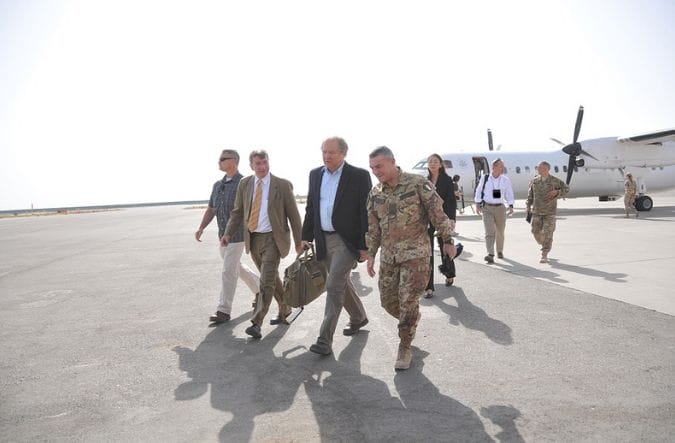One of the most important but underreported projects during the U.S. mission in Afghanistan was that of the Special Inspector General for Afghanistan Reconstruction (SIGAR), John Sopko.
Sopko has been in charge of oversight of the massive spending of U.S. tax dollars in the war-torn country.
Over 13 years, his agency unearthed billions in waste, fraud, abuse, inefficiencies and more.
Some of his cases involved criminal activity, and although referrals for prosecution were made, relatively few were actually attempted.
Now, Sopko’s office has a new report entitled, “What We Need to Learn: Lessons from Twenty Years of Afghanistan Reconstruction.”
It was compiled before the current chaos surrounding the U.S. troop withdrawal. It examined 20 years of the U.S. reconstruction effort.
Watch “Full Measure” stories on waste, fraud and abuse of U.S. taxpayers in Afghanistan.
Read more from the SIGAR’s office, and the full report, below.
Key Points:
— Twenty years later, much had improved, and much had not in Afghanistan. If the goal was to rebuild and leave behind a country that could sustain itself and pose little threat to U.S. national security interests, the overall picture in Afghanistan is bleak.
— There is no doubt, however, that the lives of millions of Afghans had been improved by U.S. government interventions, including gains in life expectancy, the mortality of children under five, GDP per capita, and literacy rates, among others. Despite these gains, the key question is whether they were commensurate with the U.S. investment or sustainable after a U.S. drawdown. In SIGAR’s analysis, they were neither.
— The U.S. government continuously struggled to develop and implement a coherent strategy for what it hoped to achieve in Afghanistan. No single agency had the necessary mindset, expertise, and resources to develop and manage the strategy to rebuild Afghanistan.
— The bureaucratic disarray over who should and would ultimately own the strategy made it more likely that senior U.S. officials would struggle to address basic challenges in that strategy. The most fundamental of questions were continuously revisited, including who America’s enemies and allies were, and exactly what the U.S. government should try to accomplish. The ends were murky, and grew in number and complexity.
The U.S. government consistently underestimated the amount of time required to rebuild Afghanistan and created unrealistic timelines and expectations that prioritized spending quickly. These choices increased corruption and reduced the effectiveness of programs.
Report by John Sopko, Special Inspector General for Afghanistan Reconstruction
— U.S. officials prioritized their own political preferences for what Afghanistan’s reconstruction should look like, rather than what they could realistically achieve. U.S. officials created explicit timelines in the mistaken belief that a decision in Washington could transform the calculus of complex Afghan institutions, powerbrokers, and communities contested by the Taliban.
— Many of the institutions and infrastructure projects the United States built in Afghanistan were not sustainable. Over time, U.S. policies emphasized that all U.S. reconstruction projects must be sustainable, but Afghans often lacked the capacity to take responsibility for projects. In response, the U.S. government tried to help Afghan institutions build their capacity, but those institutions often could not keep up with U.S. demands for fast progress. Billions of U.S. reconstruction dollars were wasted in Afghanistan as projects went unused or fell into disrepair.
— Counterproductive civilian and military personnel policies and practices thwarted the U.S. reconstruction effort in Afghanistan. The U.S. government’s inability to get the right people into the right jobs at the right times was one of the most significant failures of the mission. It is also one of the hardest to repair. U.S. personnel in Afghanistan were often unqualified and poorly trained, and those who were qualified were difficult to retain.
— Persistent insecurity severely undermined the U.S. reconstruction effort in Afghanistan. The absence of violence was a critical precondition for everything U.S. officials tried to do in Afghanistan—yet the U.S. effort to rebuild the country took place while it was being torn apart.
— At several points over the last two decades, rising insecurity forced policymakers to accept problematic compromises in the development of the country’s official uniformed security forces.
— The U.S. government did not understand the Afghan context and therefore failed to tailor its efforts accordingly. Ignorance of prevailing social, cultural, and political contexts in Afghanistan has been a significant contributing factor to failures at the strategic, operational, and tactical levels.
— U.S. officials rarely had even a mediocre understanding of the Afghan environment, much less how it was responding to U.S. interventions. Many mistakes were borne from a willful disregard for information that may have been available. In many cases, the U.S. government’s very purpose was to usher in an orderly revolution that would replace existing Afghan social systems with western or “modern” systems. If the intention was to build institutions from scratch, understanding and working within the country’s traditional systems was unnecessary.
— U.S. government agencies rarely conducted sufficient monitoring and evaluation (M&E) to understand the impact of their reconstruction efforts in Afghanistan. Unless and until agencies are permitted to dramatically increase their staffing levels for program oversight and M&E, the only way to ensure that sufficient time and attention is dedicated to M&E would be for agencies to significantly limit the scale and complexity of the programming they undertake.
— There will likely be times in the future when insurgent control or influence over a particular area or population is deemed an imminent threat to U.S. interests. If the U.S. government does not prepare for that likelihood, it may once again try to build the necessary knowledge and capacity on the fly. As seen in Afghanistan and Iraq, doing so has proven difficult, costly, and prone to avoidable mistakes.
Full Report: https://www.sigar.mil/pdf/lessonslearned/SIGAR-21-46-LL.pdf
Interactive Report: https://www.sigar.mil/interactive-reports/what-we-need-to-learn/




Our government’s profligate waste, fraud, and abuse is sickening.
It sounds like Congress here and the Americans in charge in Afghanistan just threw American dollars at complex problems thinking that the problems would magically fix themselves when instead, the money was being stolen, misappropriated, or wasted. Sound familiar? That’s exactly what Congress does here in America. Trillions of taxpayer dollars have been wasted, stolen, and misappropriated for ridiculous bills, ideas, and federal bureaucratic agencies leaving taxpayers with nothing to see for our dollars but rising debt and ever-increasing taxes.
Sharyl and Full Measure Team,
A Lesson not exposed/revealed—so not learned,
re “refugee” men of color being flown to near-to-
death White Christian America. from Afghanistan.
My post about it from another website :
“James,
“At the peak of their sex-drive!—all of
of those fighting-age/
white-female-hunting/
anti-white-male/
anti-Christian/
pro-Sharia/
neck-cutting
men of color.
“Racial mongrelization is an under-
ling tenet of Marxism/COMMU-
NISM, which is why nearly all ads
display minority men with a white
female—and white males becom-
evermore extinct in Hollywood
movies and TV commercials and
popular TV shows.”
-Rick
I feel bad for the innocent citizens of Afghanistan, mostly the children and women. However, would another 20 years made any difference? I personally don’t think so, but I wasn’t over there, nor anyone I personally know, and I do not have a military background. However, alot of good things happened, and alot of mistakes were made. Everyone needs to learn from the mistakes made.
When I was in business, if something happened, that had a bad outcome, there was a meeting of all those involved to debrief and dissect the situation to pinpoint where it all began, and how to prevent it from happening again. I hope this has or will happen with this situation!
There is no way that these people can assimilate into our culture! We should do everything we can, include threaten the Taliban, and use full force of our soldiers and equipment, to get Americans out.